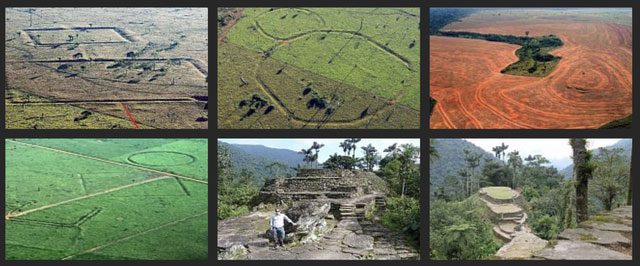Evidence of advanced civilizations living on Earth more than 100,000 years ago?
Recently, several discoveries seem to point to the possibility that ancient civilizations called planet Earth "home" much earlier than previously thought. Why mainstream researchers choose to "ignore" details and clues that point to the existence of civilizations much older than previously thought remains a puzzle for many.

These "100,000-year-old civilizations" can be found in Africa.
Evidence of civilizations inhabiting our planet before recorded history can be found in every corner of the world. In ancient Egypt, Mesoamerica and Sumer, we find writings about great civilizations in the distant past, great rulers and "golden ages" that spanned thousands of years.
One of the best examples of these "100,000-year-old civilizations" can be found in Africa. This incredible discovery actually took place at a site in South Africa, about 150 kilometers west of the port of Maputo. There, archaeologists have found the ruins of an ancient metropolis, according to the data from the tests, it has an area of about 1,500 square kilometers (almost equal to the area of Hai Phong. ).

This ancient city is just part of a mysterious community.
According to the researchers, this ancient city is just part of an even larger mysterious community measuring about 10,000 square kilometers and believed to have been built between 160,000 and 200,000 BC. The geology of the surrounding area is also quite unusual as there are many gold mines located nearby.
Researchers have suggested that the ruins may come from the ancient Anunnaki civilization, which disappeared in the distant past, who lived and settled in this area to mine gold.

In the Amazon region, other civilizations have been discovered that may predate the Incas and perhaps their ancestors. No one would have expected that somewhere in the outback of the Amazon there was a lost civilization.

About 450 geoglyphs, mostly of simple geometric shapes - squares, circles or polygons - have been found so far in an area of 13,000 square kilometers.
Rapid deforestation combined with Google Earth has enabled the discovery of hundreds of geoglyphs in 200 different locations, in a 250 km x 10 km stretch in the Amazon. Like the Nazca lines, these mysterious geometric designs by Amazon can only be truly seen and appreciated from the air.
Many of the remains are clearly part of an ancient and unknown civilization, until now appearing under the trees of the Amazon jungle. According to the researchers' conjecture, these strange shapes could be ancient irrigation canals and livestock fences.
However, for some reason no excavations have been done in the area to date, and all connections with Native American tribes to the site are only interview. We still don't know anything about the owners of these mysterious geoglyphs.
In addition, a discovery made near the border between Bolivia and Brazil found mysterious pyramids in the Amazon: Traces of a prehistoric civilization. Some researchers believe that these pyramids may have the shape of a natural pyramid, but many other researchers believe that they are structures built in the distant past. far away by a civilization never seen before.

The small dots on the NASA satellite image are suspiciously Paratoari pyramids.
However, it is a fact that the mysterious pyramidal structures were first identified through NASA's satellite image C-S11-32W071-03, published in 1976: they prove to be pyramidal structures located in primeval forests. The Machiguengas gave the name Paratoari to their sacred area. Is this a product of nature or man? Is this just an area of sacrifice to the gods or the dead city of the Incas?
These images led many investigators to venture into the Manu area, a dense rainforest in southeastern Peru, in the hope of finding out if these structures were actually built by a ancient civilization, has been lost in time or not.
While modern researchers still reject the theory that these pyramids were built by humans, other researchers have hypothesized that the space symmetry between the pyramids and the uniform shape of they show it's not a natural rock formation.
As with the Paratoari pyramids, the recent debate about the pyramids of Visoko (Bosnia) has two lines of opinion: one that is man-made, the other that the structures are natural. formed.
But no matter what, it is a fact that in the dense and tangled forests of the Amazon, there are countless mysteries that can help you understand how ancient civilizations lived in the distant past. .
- The US government is about to announce evidence that aliens have visited Earth
- Evidence of 4 billion years of life on Earth is discovered
- How far can we stand from the Earth, can we see living dinosaurs?
- Evidence clearly shows that UFOs have come to India from 6000 years ago
- Piri Reis map: evidence of an advanced civilization unprecedented on Earth?
- Hunt for evidence of aliens
- 'Diamond evidence' about the event 1.3 million years ago
- Building a hotel, digging 13 ancient civilizations
- Discover the stunned red urchin, living the longest on Earth
- The 5 oldest creatures on Earth
- Evidence shows that the Earth began a new era since 1945
- The 10 most interesting mysteries of lost civilizations (Part 2)
 Biography of hero Vu A Dinh
Biography of hero Vu A Dinh History of hematology
History of hematology Who is Mr. Tam Da 'Phuc-Loc-Tho' and what does it mean?
Who is Mr. Tam Da 'Phuc-Loc-Tho' and what does it mean? Unbelievable facts about the history of the oil and gas industry: Gasoline used to be cheaper than water, so abundant that it had to be dumped into the river...
Unbelievable facts about the history of the oil and gas industry: Gasoline used to be cheaper than water, so abundant that it had to be dumped into the river...